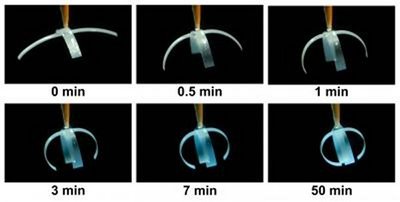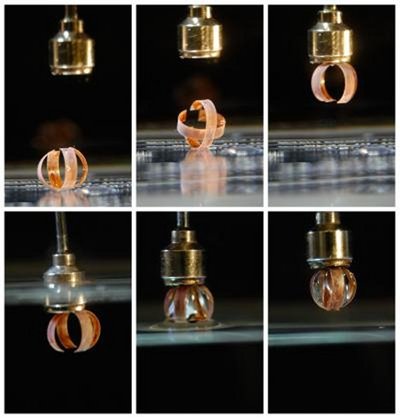Scientific use for sticky tape
Sticky tape, that versatile household staple and a mainstay of gift wrapping, may have a new scientific application as a shape-changing ‘smart material’.
Researchers used a laser to form slender half-centimetre-long fingers out of the tape. When exposed to water, the four wispy fingers morph into a tiny robotic claw that captures water droplets.

The innovation could be used to collect water samples for environmental testing, said Babak Ziaie, a Purdue University professor of electrical and computer engineering and biomedical engineering.
The sticky tape - made from a cellulose-acetate sheet and an adhesive - is uniquely suited to the purpose.
“It can be micromachined into different shapes and works as an inexpensive smart material that interacts with its environment to perform specific functions,” he said.
Doctoral student Manuel Ochoa came up with the idea. While using tape to collect pollen, he noticed that it curled when exposed to humidity. The cellulose-acetate absorbs water, but the adhesive film repels water.
“So, when one side absorbs water it expands, the other side stays the same, causing it to curl,” Ziaie said.
A laser was used to machine the tape to a tenth of its original thickness, enhancing this curling action. The researchers coated the graspers with magnetic nanoparticles so that they could be collected with a magnet.
“Say you were sampling for certain bacteria in water,” Ziaie said. “You could drop a bunch of these and then come the next day and collect them.”
The grippers close underwater within minutes and can sample one-tenth of a millilitre of liquid.

“Although brittle when dry, the material becomes flexible when immersed in water and is restored to its original shape upon drying, a crucial requirement for an actuator material because you can use it over and over,” Ziaie said. “Various microstructures can be carved out of the tape by using laser machining. This fabrication method offers the capabilities of rapid prototyping and batch processing without the need for complex cleanroom processes.”
The materials could even be ‘functionalised’ so that they attract specific biochemicals or bacteria in water.
These findings were detailed in a presentation briefly titled ‘Laser-Micromachined Magnetically-Functionalized Hygroscopic Bilayer: A Low-Cost Smart Material’ at the Materials Research Society meeting in Boston (25-30 November). Experiments at Purdue’s Birck Nanotechnology Center were conducted by Ochoa, doctoral student Girish Chitnis and Ziaie.
Best practices for safe centrifugation in the laboratory
The majority of all centrifuge accidents are understood to result from user error. These tips...
Nature-inspired filtration system recovers critical resources
A filtration system that can recover untapped critical resources such as copper and lithium from...
Optimising food and beverage testing with laboratory equipment
In the food and beverage industry, laboratories must balance precision, speed and compliance to...





